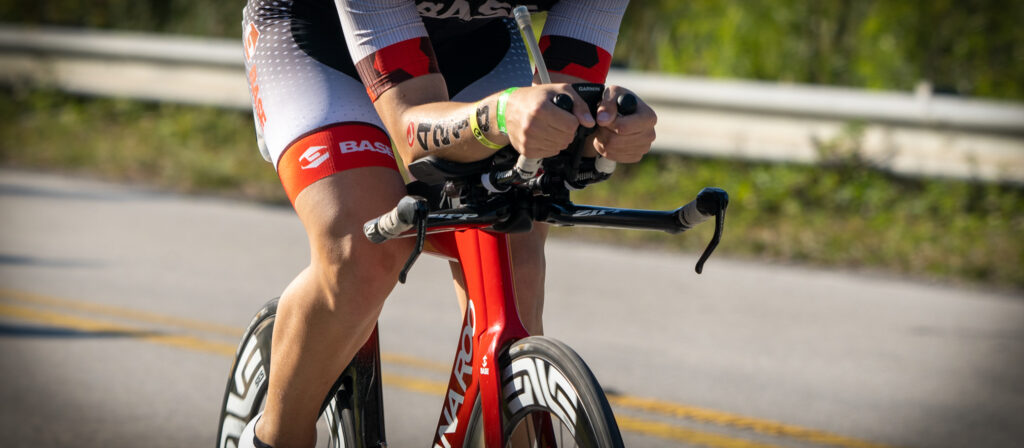In the 1980s, aerobars were a huge aerodynamic breakthrough. Innovated by triathletes and later adopted by cyclists for time trials, aerobars proved consistent and significant power saving and speed gains in wind tunnel testing. The goal for fast triathlon riding is to stay in an aerodynamic position as much as possible, which means developing the physical ability and riding confidence to stay in your TT bars. Professional triathletes will spend almost an entire Ironman bike in streamline and will tailor their training to adapt their back and body to be most efficient in that aero position. If you watch a non-drafting triathlon you will often observe novice athletes sitting up and giving up speed because they are less comfortable or confident in their aero position.
Consider these key factors for developing aerobar bike skills:
1) Riding in aerobars is a skill that we acquire early as triathlon cyclists. It still requires practice. On a flat road and in an open space it’s not so challenging. But what about descending and climbing? It takes confidence to allow speed on the downhills and experience to know when to sit up on the uphill.
Skill progression: Descend on a lesser grade with few turns and a clear braking path, pedaling in your aerobars if you’re comfortable. As you get more confident try gradually quicker descents. Add some slight curves. As for climbing, stay in aerobars and systematically gear down according to the increasing grade. Practice shifting the appropriate number of gears so that you don’t lose pressure against the pedal and spin out. With experience you can look forward to a hill and anticipate the grade change, shifting before your cadence drops too low and maintaining constant pressure on the pedals. Many athletes sit up too early into a climb. It is beneficial to stay aero as long as you are traveling faster than 12 to 15 mph. If you do sit up, remember to get right back into your aerobars as you crest the hill and accelerate. Shifting well through a rolling course to maintain an even, steady power output takes practice.
2) Predictable, straight-line riding is important. It shows consideration to your fellow competitors and reduces your likelihood of causing an accident. Biking safely becomes more challenging as you deal with eating and drinking, starting your bike computer, grabbing water bottles on the course, and riding in different terrains with wind. You are far less likely to collide with another rider if you are predictable. If you sit and stand, swerve, or brake unexpectedly, you are more likely to cause an accident. Riding consistently also saves energy and produces a smoother power profile with fewer power spikes. Always be conscious of your environment and practice your skills without disrupting your rhythm or your line.
Skill progression: Practice reaching behind you with one hand and then the other while still in the aero position. Touch the back your seat; then progress to taking a water bottle out of a rear bottle cage. Start slowly and focus on not swerving. Reach down between your legs for a water bottle while still pedaling, first seated and then in the aero position. Shoulder check over one shoulder and then the other without swerving. Practice going from base bars to aerobars and back to base bars without surging or wavering offline. Practice going from aerobars to base bars and standing without accelerating or slowing erratically. To really tighten up your ability to hold a straight line, try following a line on the road without inching away from it. Have fun with it! Practice these skills regularly with a friend or teammate and you’ll see your confidence and speed improve.
3) Cornering is important in triathlon. Whether biking in a straight line or around a corner, staying in your aerobars is always faster than standing or sitting up. With practice you can learn to maintain speed while cornering safely. Over-braking robs you of momentum, subsequently requiring more power to re-accelerate, costing you energy.
Skill progression: Find a quiet area with 90 degree turns and practice taking a wider arc through the turn at a low speed with the bike more upright. Reduce the arc of the turn by starting wide, riding tight through the turn and finishing wide. As you grow more confident, gradually increase your speed pedaling through the turn. As you get more familiar with your bike, figure out how fast and tight you can corner while still pedaling without catching your pedal on the ground as the angle of the bike changes. As you grow more confident, go back to slower speeds and practice cornering in your aerobars. Repeat the progression. You can also try cycling on a running track in your aerobars to get comfortable riding turns in a more controlled environment. Finally, take the same cornering progression into downhills, sitting up first, and then moving into the aerobars. Always ride within your skill set and build a gradual progression for yourself. Don’t take unnecessary risk. Some corners are too sharp to pedal and too extreme for aerobars. Make sure that you practice turning in both directions.
Smooth riding is safe and aerodynamic is fast. Create gradual skill progressions and become more confident riding in all circumstances in your aerobars.
Lance Watson, LifeSport head coach, has trained many Ironman, Olympic and age-group champions over the past 30 years. He enjoys coaching athletes of all levels. Contact coach@lifesportcoaching.com to tackle your first Ironman or to perform at a higher level.
